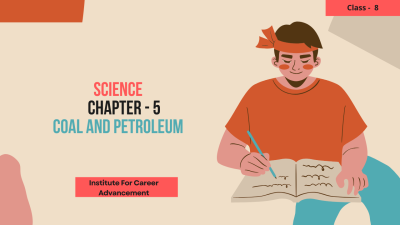Coal And Petroleum - Class 8
Coal and petroleum are fossil fuels found in earth’s crust. They are non-renewable and exhaustible resources. Coal is a combustible fossilized rock derived from a large accumulation of plant remains that is gradually compressed. It occurs in many countries like China, Japan, U.S.A, Iran, Kuwait, India, etc. It is used for cooking, heating in industry and thermal power plants. The coal reserve will last for another two hundred years. Petroleum is another fossil fuel that occurs in the form of liquid-oil. It has been formed from plant and animal remains. Petroleum is mainly used as fuel for transport, agricultural operations, generators and some industries. The petroleum resource will last for another forty years. Kerosene and LPG (liquified petroleum gas), obtained from petroleum are used as domestic fuels for cooking food, etc. কয়লা এবং পেট্রোলিয়াম হল পৃথিবীর ভূত্বকের মধ্যে পাওয়া জীবাশ্ম জ্বালানি। এগুলি অ-পুনর্নবীকরণযোগ্য এবং নিঃশেষযোগ্য সম্পদ। কয়লা একটি দাহ্য জীবাশ্ম শিলা যা উদ্ভিদের অবশিষ্টাংশের একটি বড় সংগ্রহ থেকে উদ্ভূত হয় যা ধীরে ধীরে সংকুচিত হয়। এটি চীন, জাপান, U.S.A, ইরান, কুয়েত, ভারত ইত্যাদির মতো অনেক দেশে ঘটে। এটি রান্নার জন্য, শিল্পে গরম করার জন্য এবং তাপবিদ্যুৎ কেন্দ্রগুলিতে ব্যবহৃত হয়। কয়লা মজুদ আরও দুইশো বছর স্থায়ী হবে। পেট্রোলিয়াম হল আরেকটি জীবাশ্ম জ্বালানি যা তরল-তেল আকারে পাওয়া যায়। এটি উদ্ভিদ এবং প্রাণীর অবশিষ্টাংশ থেকে গঠিত হয়েছে। পেট্রোলিয়াম প্রধানত পরিবহন, কৃষি কাজ, জেনারেটর এবং কিছু শিল্পের জন্য জ্বালানী হিসাবে ব্যবহৃত হয়। পেট্রোলিয়াম সম্পদ আরও চল্লিশ বছর স্থায়ী হবে। পেট্রোলিয়াম থেকে প্রাপ্ত কেরোসিন এবং এলপিজি (তরল পেট্রোলিয়াম গ্যাস) রান্নার খাদ্য ইত্যাদির জন্য গার্হস্থ্য জ্বালানী হিসাবে ব্যবহৃত হয়।
English
Last updated
Wed, 27-Nov-2024



















